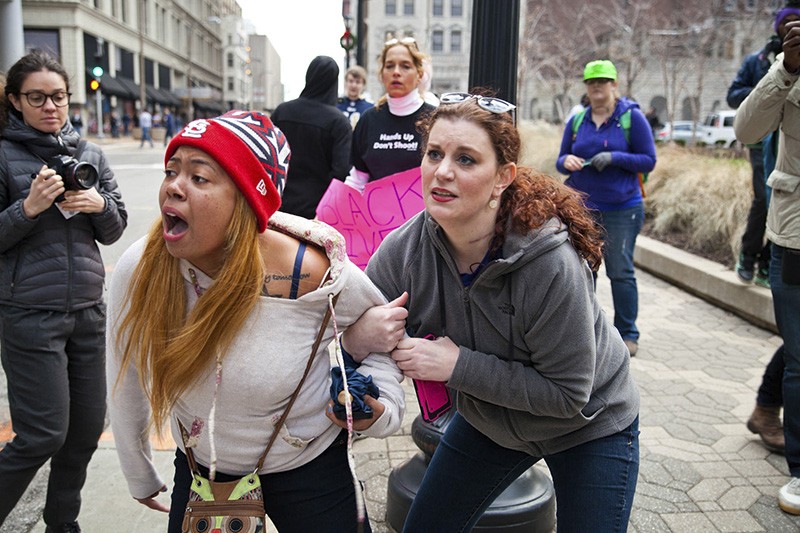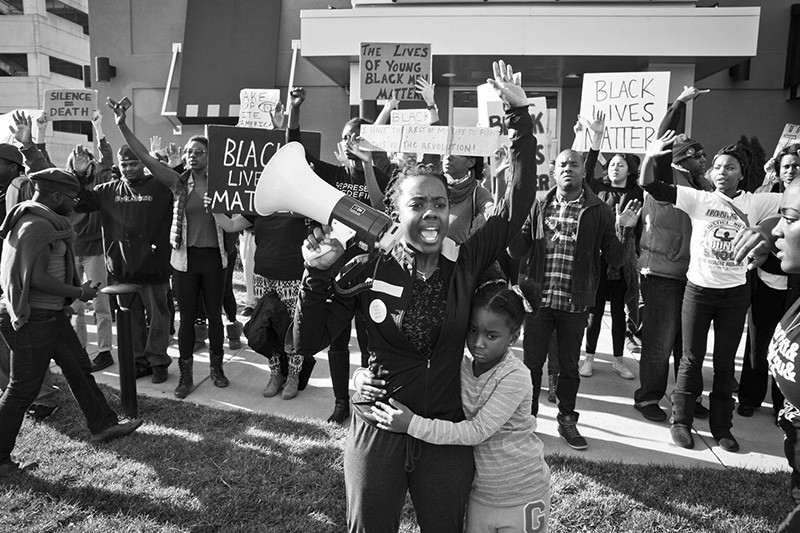For some people, 2014 was the spark that lit the fuse for a new civil rights movement. Throughout the country, the deaths of Michael Brown, Eric Garner, Tamir Rice and other black men and women at the hands of white police officers drove discussions about racial bias and discriminatory injustices. Many citizens — often white — wondered, "How could this happen?"
But for Ferguson residents and African-Americans in general, this was nothing new; they'd witnessed and endured systemic racism in their communities for decades. The difference in 2014 was that it was time to fight back.
St. Louis artist and filmmaker Damon Davis captures those early days of the Black Lives Matter movement in his new 103-minute film Whose Streets?, which competes this week at the 2017 Sundance Film Festival in Park City, Utah. Billed by the New York Times as one of the festival's four "films to know," the documentary offers exclusive footage and community commentary after Michael Brown was shot and killed by Ferguson officer Darren Wilson in August 2014. Davis, who followed protesters and activists for two years while working on the project, says that while plenty of news cameras captured the action, they showed an incomplete picture.
"We're trying to get the idea across that there are missing pieces to this. You only got to see the parts that work for an agenda," Davis says. "That's why it was so easy for people to say, 'Well, why are they so angry?' It's because you didn't see this other part."
Hundreds of protesters took to the streets to protest Brown's death and demand justice for the systemic, discriminatory practices that had been shadowing the St. Louis area for decades, Davis says. At times, Ferguson resembled a war zone as police and National Guard members eventually used tear gas, rubber bullets and other military tactics on protesters.
"From where I stood, we were the ones victimized," Davis says. "We didn't have military-grade weaponry. It was normal people against the Army — and all of this just for asking questions."
Those citizens are the ones Davis and co-director Sabaah Folayan feature in Whose Streets?, showing through interviews and on-the-ground footage how sustained racial tensions and brutal force affected people of color at a pivotal time in modern history.
"The idea is that people lived this; it's not a narrative," Davis says. "We show you the humanity of black people, the humanity of these people. We show you them in a full spectrum of emotion.
"That's something that black people never get," Davis continues. "We always get 'angry looters,' 'rioters,' 'drug dealers,' or we're 'super-human athletes,' or something like that. But you never get to see the in-between. Just seeing black people, black bodies, at rest in a normal setting is something that is very important to me and to my directing partner."
Davis views Ferguson as the latest front in an ongoing civil rights battle in the United States, but acknowledges the movement dramatically raised the stakes.
"Nothing was this adamant with people taking the streets in protest en masse and fighting for our communities like this," Davis says. "I think we honor that in this film, and we show that this sparked a lot of other stuff going on throughout the country and throughout the world. It's a time capsule, to a certain degree."

Davis, who was raised in East St. Louis, has exhibited his paintings and sculpture in galleries and museums across the country, including in New York City and San Diego. In St. Louis, he's also known for his multi-disciplinary series on Afrofuturism — an ongoing sci-fi commentary about current and future "alternative blackness." Davis continues that exploration through his recent solo work LOA and as the founder of the FarFetched Collective, which finds local musicians collaborating across race, gender and genre lines on some of the city's most civic-minded tunes. And last fall, Davis led a boycott against a racially charged exhibit at the Contemporary Art Museum-St. Louis, driving the museum to erect walls around the offending works and host community conversation about race and art.
All the while, Davis' star has been rising. Just this month, global conference TED named Davis as one of its TED2017 Fellows, and in November the Regional Arts Commission of St. Louis awarded him a $20,000 fellowship.
"I've had lots of ideas for a long time that I can finally actually put into practice because of that grant," Davis says, noting that he plans to use the funds for another film as well as a top-secret "big idea" involving visual art and installation.
But as wonderful as those honors are, the Sundance selection certainly looms large, especially since the high-profile honor came for a project that wasn't initially on Davis' horizon. As a creator and activist, Davis was well-known in Ferguson — one reason that acquaintances connected him with Whose Streets? co-director Folayan. Davis' adamance that a St. Louisan help tell the town's story led to their cinematic collaboration.
"I think it's some of the best stuff I've ever been a part of as a creative, to be honest," Davis says. "Sundance has been an avid supporter of this project from the beginning. We're just honored that they accepted it, so we'll see once it's released what the public thinks about it."
Davis sees creatives as key to discussions taking place across the globe.
"[Artists] are necessary — especially right now — because we're at a pivotal point, not just in American history, but in humanity," he says.
"The decisions we make in this generation and maybe the next one are going to say whether the human race continues. We're talking about actual change and getting past the differences that we have, whether it be racism, sexism or homophobia. If we don't get past these things now, there won't be a race on the planet left."


